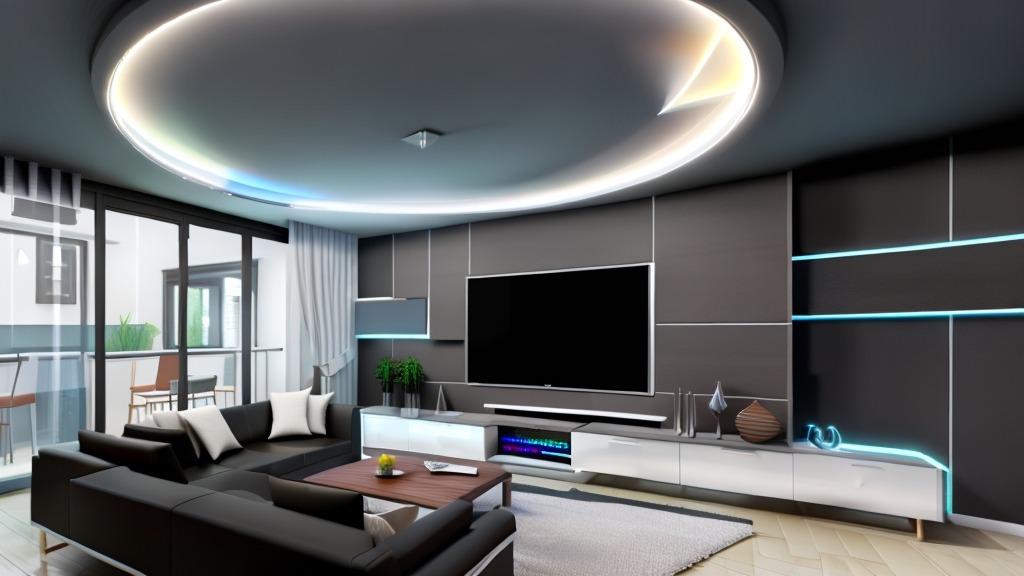Creating a Smart Home with Automation

In today’s world, technology has become an integral part of our daily lives. From smartphones to smart cars, we are surrounded by devices that make our lives more convenient and efficient. One area where technology has made significant advancements is in our homes. Smart homes, equipped with automation, are revolutionizing the way we live. In this article, we will explore what a smart home is, why you should consider creating one, the different types of automation available, how to create a smart home, the future of smart homes, and best practices for getting started.
What is a Smart Home?
A smart home, as the name suggests, is a home that is equipped with devices and systems that can be controlled and automated, enhancing the convenience and efficiency of everyday living. From controlling the lights and thermostat with a simple voice command to remotely monitoring your security cameras, a smart home offers a whole new level of control and ease of use.
How does automation work in a smart home?
Automation is the heart of a smart home. It allows different devices and systems to communicate with each other and perform tasks automatically, based on preset conditions or triggered by user commands. For example, you can set up your smart home to turn off all the lights and lower the thermostat when you leave the house, or have your coffee maker start brewing as soon as you wake up in the morning.
The benefits of a smart home:
There are numerous benefits to creating a smart home.
Here are a few key advantages:
Convenience: With automation, you can control and manage various aspects of your home with a simple voice command or through a smartphone app. Whether it’s adjusting the temperature, turning on the lights, or playing your favorite music, a smart home makes life more convenient.
Cost savings: A smart home can help you save money on energy bills by optimizing the use of electricity, water, and heating/cooling systems. For example, smart thermostats can learn your heating and cooling preferences and automatically adjust the temperature to save energy when you’re away.
Security and safety: Smart home security systems provide enhanced safety by offering features like motion sensors, door/window sensors, and surveillance cameras that can be monitored remotely. You can also receive real-time alerts on your smartphone if any unusual activity is detected, ensuring your home and loved ones are protected.
Why You Should Create a Smart Home
The idea of creating a smart home may seem intriguing, but you might be wondering why it’s worth the investment. Let’s explore some compelling reasons why you should consider turning your home into a smart home.
The convenience of a smart home:
One of the main reasons people opt for smart home automation is the convenience it offers. Imagine being able to control various aspects of your home with just a few taps on your smartphone or a voice command to your virtual assistant. You can dim the lights, adjust the thermostat, lock the doors, or even close the blinds, all without having to get up from your sofa.
The cost savings of a smart home:
In addition to convenience, a smart home can also help you save money in the long run. Smart devices, such as thermostats and lighting systems, are designed to be energy-efficient and optimize resource usage. For example, a smart thermostat can learn your temperature preferences and adjust the heating or cooling accordingly, resulting in significant energy savings over time.
The security and safety advantages of a smart home:
Another compelling reason to create a smart home is the enhanced security and safety it provides. With smart security systems, you can monitor your home remotely and receive instant alerts on your smartphone if any suspicious activity is detected. You can also integrate smart locks and door/window sensors to ensure that your home is secure at all times. Additionally, some smoke detectors and carbon monoxide detectors can be connected to your smart home system, giving you early warnings in case of emergencies.
Types of Automation for a Smart Home
When it comes to creating a smart home, there are various types of automation that you can incorporate.
Let’s explore some of the most common types:
Home security automation:
Home security automation allows you to monitor and control the security of your home remotely. This can include features such as surveillance cameras, motion sensors, door/window sensors, smart locks, and alarm systems. By integrating these devices into your smart home system, you can monitor your home’s security in real-time and receive alerts if any unusual activity is detected.
Energy management automation:
Energy management automation focuses on optimizing energy usage within your home. This can include features like smart thermostats, smart lighting systems, smart power outlets, and energy monitoring devices. By automating these systems, you can control and monitor your energy usage, set schedules to turn off lights and appliances when not in use, and receive insights on your overall energy consumption.
Entertainment automation:
Entertainment automation allows you to create a personalized and immersive home entertainment experience. This can include features like smart speakers, streaming devices, home theater systems, and smart TVs. By integrating these devices into your smart home system, you can control and automate your audio and video devices, stream your favorite music and movies, and create customized scenes for different entertainment scenarios.
Home appliance automation:
Home appliance automation focuses on automating everyday household tasks. This can include features like smart kitchen appliances (e.g., refrigerators, ovens, coffee makers), smart laundry appliances (e.g., washers, dryers), and robot vacuum cleaners. By automating these appliances, you can control and monitor their functions remotely, set schedules for tasks like brewing coffee or starting laundry, and receive alerts when tasks are completed.
How to Create a Smart Home with Automation
Now that you understand the benefits of a smart home and the different types of automation available, let’s explore how you can create your own smart home.
Here’s a step-by-step guide:
1. Assess your needs and priorities:
The first step in creating a smart home is to assess your needs and priorities. Consider the features and functionalities you want in your smart home and prioritize them based on your lifestyle and budget. Do you want to focus on security, energy management, entertainment, or a combination of these? Understanding your needs will help you make informed decisions during the setup process.
What features do you want in your smart home?
Security: Do you want to install surveillance cameras, motion sensors, or smart locks?
Energy management: Do you want to control your thermostat, lighting, or power outlets?
Entertainment: Do you want to integrate smart speakers, streaming devices, or a home theater system?
Home appliances: Do you want to upgrade to smart kitchen appliances, laundry appliances, or robot vacuum cleaners?
2. Choose a smart hub or controller:
Once you have identified your needs, it’s time to choose a smart hub or controller. A smart hub acts as the central command center for your smart home, allowing you to control and automate different devices and systems from a single interface. Here are some popular smart home hubs on the market:
Popular smart home hubs on the market:
Amazon Echo (Alexa)
Google Nest Hub
Apple Home-Pod
Samsung SmartThings Hub
Considerations when selecting a smart hub or controller:
Compatibility: Ensure that the smart hub you choose is compatible with the devices and systems you want to incorporate into your smart home.
User interface: Look for a smart hub with an intuitive user interface that is easy to navigate and control.
Expandability: Consider a smart hub that allows for future expansion and integration with additional devices and platforms.
3. Smart lighting and switches:
Smart lighting and switches are an essential part of any smart home. They allow you to control your lights remotely, set schedules, and create customized lighting scenes.
Here’s how you can get started:
Installing smart light bulbs and switches:
To install smart light bulbs, simply replace your existing bulbs with smart bulbs that are compatible with your smart hub. For smart switches, you may need to hire an electrician to install them. Once installed, you can easily control the lights using your smartphone or voice commands.
Benefits of smart lighting in a smart home:
Convenience: Control your lights from anywhere, anytime, without having to manually switch them on or off.
Energy efficiency: Set schedules and dimming levels to save energy and reduce electricity bills.
Security: Use lighting automation to make your home appear occupied when you’re away, deterring potential intruders.
4. Smart thermostats:
Smart thermostats are another key component of a smart home. They allow you to control and automate your heating and cooling systems, providing energy savings and comfort.
Here’s how you can install a smart thermostat:
Installing a smart thermostat:
Installation may vary depending on the model, so it’s essential to follow the manufacturer’s instructions. In general, you’ll need to replace your existing thermostat with the smart thermostat. This may involve disconnecting wires and mounting the new thermostat onto the wall. Once installed, you can connect it to your smart hub and control it remotely.
Advantages of a smart thermostat in a smart home:
Energy savings: Smart thermostats can learn your habits, optimize temperature settings based on your preferences, and adjust accordingly, resulting in energy savings and reduced utility bills.
Comfort: Control your thermostat remotely, so your home is always at the desired temperature when you arrive.
Voice control: Most smart thermostats are compatible with virtual assistants, allowing for voice commands and hands-free control.
5. Home surveillance and security systems:
Home security is a top priority for many homeowners, and smart home automation offers advanced solutions for monitoring and protecting your property.
Here’s how you can set up a home surveillance system:
Setting up a home surveillance system:
To set up a home surveillance system, you’ll need surveillance cameras, motion sensors, and a smart hub or security system. Install the cameras at strategic locations around your home and connect them to your smart hub or security system. You can then monitor the cameras remotely through your smartphone or computer.
Benefits of a smart security system in a smart home:
Remote monitoring: Keep an eye on your home’s security from anywhere, allowing for peace of mind when you’re away.
Real-time alerts: Receive instant alerts on your smartphone if any unusual activity is detected, enabling you to take immediate action.
Integration with other devices: Integrate your security system with other smart devices, such as smart locks and door/window sensors, for added protection and convenience.
6. Smart entertainment systems:
Smart entertainment systems can transform your living space into a personalized and immersive experience.
Here’s how you can install smart speakers and streaming devices:
Installing smart speakers and streaming devices:
To install smart speakers, simply connect them to your smart hub or compatible music streaming services. For streaming devices, such as smart TVs or media players, connect them to your home network and set them up according to the manufacturer’s instructions.
How smart entertainment enhances your smart home experience:
Voice command: Control your music and entertainment using voice commands, eliminating the need for remote controls or smartphone apps.
Seamless integration: Stream music or videos from various sources and services, providing a unified and seamless entertainment experience.
Personalization: Create customized scenes that combine lighting, music, and video settings to match your mood or activity, such as a cozy movie night or a lively party ambiance.
7. Smart appliances and devices:
Smart appliances offer convenience and efficiency by automating everyday household tasks.
Here’s how you can upgrade to smart appliances:
Upgrading to smart appliances:
When it comes to smart appliances, you can start by replacing your existing appliances with smart versions. Look for models that are compatible with your smart hub or controller. Smart kitchen appliances, for example, can offer features like remote control, voice commands, and integration with recipe apps. Smart laundry appliances can provide notifications on cycle progress and energy usage.
Benefits of smart appliances in a smart home:
Remote control: Control and monitor your appliances remotely, no matter where you are.
Energy efficiency: Optimize energy usage and reduce utility bills by setting schedules and utilizing energy-saving features.
Convenience: Receive notifications or alerts when tasks are complete, eliminating the need to constantly check on your appliances.
https://serenity7wellness.com/index.php/2023/12/12/the-pillars-of-health-why-it-matters/
Best Practices for Creating a Smart Home with Automation
To ensure a smooth and successful experience in creating your smart home, here are some best practices to follow:
How to ensure compatibility between devices:
Research compatibility: Before purchasing any smart devices, research and ensure compatibility with your smart hub or controller.
Stick to one ecosystem: To minimize compatibility issues, consider sticking to devices and platforms from the same ecosystem, such as Amazon Alexa or Google Assistant.
Read user reviews: User reviews can provide valuable insights into compatibility issues and possible workarounds.
Ensuring security and privacy in a smart home:
Create strong passwords: Use unique and strong passwords for all your smart home devices and platforms.
Regularly update firmware and software: Stay up to date with the latest firmware and software updates for your devices, as these often include security patches.
Secure your home network: Set up a secure home network with a strong password, enable network encryption (e.g., WPA2), and consider adding a firewall or using a separate network for your smart devices.
Regular maintenance and updates for a smart home:
Schedule regular updates: Regularly check for firmware and software updates for your smart devices, and install them as soon as they become available.
Monitor performance: Keep an eye on the performance of your smart home devices and systems, and address any issues promptly.
Review your automation settings: Regularly review and update your automation settings to ensure they align with your needs and desires.
Conclusion
As we move forward into the future, smart homes with automation will continue to evolve and shape the way we live. The convenience, cost savings, and security advantages of smart homes make them a worthy investment for homeowners. By following the step-by-step guide and best practices outlined in this article, you can create a smart home that integrates seamlessly with your lifestyle. Embrace the power of automation and get ready to experience the future of living in a smart home.







